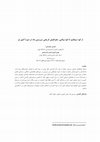Papers by Sa'di (Hunar) Saeedyan
Antiquity, 2010
In the summer of 2009 an archaeological survey was carried out on the Delijan Plain in the south-... more In the summer of 2009 an archaeological survey was carried out on the Delijan Plain in the south-east of Markazi Province in the central plateau of Iran (Figure 1). The survey formed part of a campaign spanning the last two decades to identify the settlement patterns of the ...
گزارش های هفدهمین گردهمایی سالانه باستان شناسی ایران, 2020
گزارش های هفدهمین گردهمایی سالانه باستان شناسی ایران, 2020

مجموعه مقالات عصر آهن در غرب ایران و مناطق همجوار, 2019
study of ritual behaviors and religious systems of ancient societies have always been a ma� jor c... more study of ritual behaviors and religious systems of ancient societies have always been a ma� jor concern for historians and archaeologists of ancient Near East. Compared to the better known Mesopotamia, we have very little information about religious and mythological systems of the Ira� nian Iron Age populations. In the lack of textual and evidence, archaeological finds from excavations are very helpful in reconstruction of ideological systems of the ancient societies. In this context, the author examines three architectural decorative elements commonly used in the Iron Age temples of Zagros region and central Plateau of Iran. This study suggests that the use of painted bricks, doors and small recessed niches during the Iron Age in Iran was inspired by the Mesopotamian religious art mainly practiced in sanctuaries and temples as well as ceremonial buildings probably intended to represent divinity and legitimacy of the monarchs and kings power.
مقالات منتخب اولین کنفرانس ملی باستان شناسی و تاریخ هنر ایران، دانشگاه بابلسرۀ اردیبهشت 1398, 2019
مجله مطالعات باستان شناسی، دوره 11، شماره 1 Journal of Archaeological Studies, vol. 11, Issue 1, 2019
پژوهش های باستان شناسی ایران، شماره 19، دوره هشتم PAZHOHESH-HA-YE BASTANSHENASI IRAN, vol. 8, number 19, 2019
گزارشهای شانزدهمین گردهمایی سالانه باستان شناسی ایران (مجموعه مقالات سال 96, 2018

Journal of Archaeological Studies, 2017
The problem of historical geography and extent of Median territory in Neo-Assyrian period, from 9... more The problem of historical geography and extent of Median territory in Neo-Assyrian period, from 9th to 7th centuries B.C. has always made dissensions. Given the extent of Median territory in Achaemenid and Parthian periods, early historians and Assyriologists in the late 19th and early 20th centuries considered Median realm extending from Zagros mountains to central plateau of Iran. From 1970s onwards, however, a new minimalistic approach to the historical geography of Neo-Assyrian Zagros has appeared and proposed a large Median territory than previously assumed and located Media on the western flanks of Alvand Mountain ranges. The advocates of this minimalistic approach have put limits on the extent of Assyrian dominance in Iran and consider the Alvand as the last spot of Assyrian Armies’ penetration to the east. The present study deals with assessing these contradictory assumptions. We also try to determine the Median boarders and also try to locate the main regions and cities of Media based on the Assyrian written sources.
مجموعه مقالات چهارمین همایش بین المللی باستان شناسان جوان، دانشگاه تهران، آبان 1394, 2015
Iranica Antiqua, vol. XLIX, 2014
Zar Bolagh is located in the north of Qom province, central Iran. The site is known for its stone... more Zar Bolagh is located in the north of Qom province, central Iran. The site is known for its stone structure, which after its abandonment was deliberately filled with stone and gravel, similarly to Nush-i Jan, before finally being entirely covered by two thick stone and mud brick walls founded by mortar. In the winter of 2006, and under Malekzadeh's supervision, Zar Bolagh was investigated. During the course of excavation the team found valuable architectural elements comparable with other religious monuments in central Iran. This paper presents some preliminary results from the first season of excavation in Zar Bolagh, consisting of cemetery data and architectural remains. According to the pottery assemblage sequence this site can be dated to as early as the Late Iron Age.
دوازدهمین گردهمایی سالانه باستان شناسی ایران، اردیبهشت 93, 2014
Antiquity, Vol. 084, Issue 323, 2010
مجموعه مقالات همایش بین المللی باستان شناسان جوان، 1393, 2014
Conference Presentations by Sa'di (Hunar) Saeedyan
The Second colloquia Iranica Baltica 2015, Rzucewo, 04-08 December 2015, Poland., 2015











Uploads
Papers by Sa'di (Hunar) Saeedyan
Conference Presentations by Sa'di (Hunar) Saeedyan